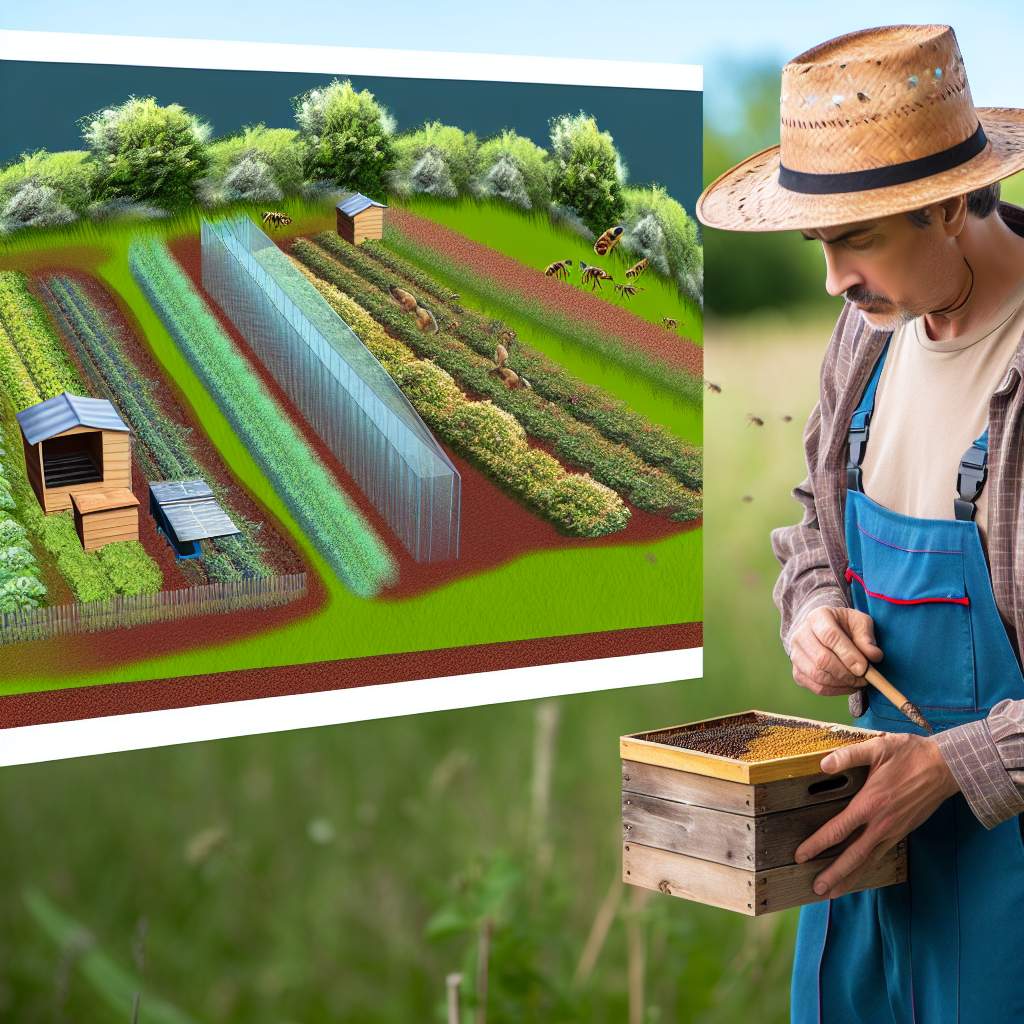Introduction to Beneficial Insects and Their Role in Agriculture
Beneficial insects play a critical role in sustainable agriculture.
They contribute to pest control, pollination, and soil health.
Understanding these insects can significantly enhance farm biodiversity.
The Importance of Beneficial Insects
Beneficial insects help maintain ecological balance on farms.
They can naturally reduce pest populations without harmful chemicals.
Pollinators, such as bees, ensure crops produce efficiently.
Additionally, some beneficial insects enhance soil fertility.
Key Types of Beneficial Insects
Various beneficial insects can be found on US farms.
Common examples include ladybugs, lacewings, and predatory wasps.
These insects target harmful pests like aphids and caterpillars.
Pollinators like bees and butterflies contribute directly to crop yields.
Soi-dwelling insects, such as earthworms, aid in nutrient cycling.
Enhancing Biodiversity Through Habitats
Creating habitats for beneficial insects can boost populations.
Farmers should consider planting diverse cover crops.
Maintaining hedgerows and floral strips provides food and shelter.
Transform Your Agribusiness
Unlock your farm's potential with expert advice tailored to your needs. Get actionable steps that drive real results.
Get StartedOrganic farming practices support healthy insect populations.
Integrating these habitats enhances overall farm resilience.
Challenges Faced by Beneficial Insects
Beneficial insects face threats from habitat loss and pesticide use.
Intensive farming often reduces their natural habitats.
Pesticides can harm or kill these essential insects directly.
Therefore, minimizing chemical use is crucial for their survival.
Encouraging Beneficial Insect Populations
Farmers can implement several strategies to attract beneficial insects.
Planting native wildflowers can increase local insect diversity.
Providing water sources helps sustain beneficial insect populations.
Using cover crops can enhance soil health and insect habitat.
Regular monitoring of pest and insect populations informs management decisions.
Importance of Biodiversity on Farms: An Overview
Biodiversity is crucial for the resilience of agricultural systems.
It enhances ecosystem services that support farming productivity.
These services include pollination, pest control, and nutrient cycling.
Moreover, diverse ecosystems can better withstand environmental changes.
This resilience is vital in the face of climate change challenges.
Enhancing Soil Health
Biodiversity improves soil health and structure.
Different plant roots and microorganisms promote nutrient availability.
They also help with water retention in the soil.
This leads to healthier crops and improved yields.
Promoting Pest Control
Diverse habitats encourage natural pest predators.
This reduces reliance on chemical pesticides.
Beneficial insects, such as ladybugs and lacewings, thrive in biodiverse environments.
These insects can control pest populations effectively.
Showcase Your Farming Business
Publish your professional farming services profile on our blog for a one-time fee of $200 and reach a dedicated audience of farmers and agribusiness owners.
Publish Your ProfileSupporting Pollination
A diverse array of plants attracts various pollinators.
Bees, butterflies, and other insects are essential for crop pollination.
In short, more varieties of flowering plants result in higher pollination rates.
This dramatically enhances crop quality and quantity.
Building Ecological Resilience
Ecological resilience stems from a rich diversity of species.
It enables systems to recover from disturbances more rapidly.
This adaptability is crucial as agricultural conditions continue to evolve.
Farms that foster biodiversity are better positioned in changing climates.
Economic Benefits
Investing in biodiversity can yield economic advantages for farmers.
Reduced pest outbreaks lower pesticide costs.
Biodiversity also supports premium pricing for sustainable products.
Consumers increasingly value sustainably produced foods.
Regulatory Considerations
Government policies increasingly encourage biodiversity on farms.
Programs like conservation grants support biodiversity initiatives.
Farmers can benefit from financial incentives for sustainable practices.
Engaging with these programs can boost a farm’s viability.
Types of Beneficial Insects
Predators
Predators play a crucial role in controlling pest populations.
They actively hunt and consume other insects.
Common predators include ladybugs and lacewings.
These beneficial insects help minimize the need for chemical pesticides.
Encouraging predators on farms boosts crop health.
Parasitoids
Parasitoids are insects that lay eggs in or on other insects.
When the eggs hatch, the larvae feed on the host insect.
This process ultimately leads to the host’s death.
Common parasitoids include certain wasps and flies.
They offer a natural way to manage pest populations.
Pollinators
Pollinators are essential for the fertilization of flowering plants.
They transfer pollen from one flower to another, promoting reproduction.
Bees and butterflies are among the most effective pollinators.
Increasing pollinator habitats enhances fruit and vegetable yields.
Farmers can improve pollinator diversity by planting diverse flowering plants.
Gain More Insights: Food Waste Reduction Benefits for Regenerative Farming Systems
Creating Habitats for Beneficial Insects
Understanding the Importance of Beneficial Insects
Beneficial insects play a crucial role in agriculture.
They contribute to pollination and pest control.
Farmers can achieve higher yields through their activity.
Thus, fostering these insects is vital for sustainable farming.
Choosing the Right Location
Identifying suitable areas on the farm is essential.
Look for regions with diverse habitats.
Fields near hedgerows or wildflower patches are ideal.
Accessibility to water sources can also attract beneficial insects.
Showcase Your Farming Business
Publish your professional farming services profile on our blog for a one-time fee of $200 and reach a dedicated audience of farmers and agribusiness owners.
Publish Your ProfilePlanting Diverse Flora
Planting a variety of flowering plants enhances insect habitats.
Include native plants that bloom at different times of the year.
This strategy provides consistent food sources for the insects.
Moreover, consider incorporating cover crops.
These can improve soil health and attract beneficial insects.
Implementing Sustainable Practices
Minimizing pesticide use helps protect beneficial insect populations.
Instead, rely on integrated pest management (IPM) strategies.
This approach combines biological control and cultural practices.
Moreover, avoid monoculture farming practices.
Diversity in crops enhances habitat for beneficial insects.
Building Insect Hotels
Creating insect hotels provides nesting sites for various beneficial insects.
Use natural materials like twigs, leaves, and straw.
Ensure the hotels are in sunny, dry locations.
This encourages insects such as bees and ladybugs to inhabit them.
Maintaining Habitats Through Observation and Care
Regularly observe beneficial insect populations on your farm.
Monitor their activity and the overall health of habitats.
Taking notes can help track changes over time.
Actively manage habitats based on these observations.
Regular maintenance ensures long-term success for beneficial insect populations.
Find Out More: Farm-to-Restaurant Programs for Local Farmers
Best Plants for Attracting Beneficial Insects: A Plant Guide
Top Flowering Plants
Flowering plants attract a variety of beneficial insects.
Consider planting native wildflowers.
They often thrive in your local climate.
Examples include coneflowers and butterfly weed.
These flowers provide nectar and pollen for pollinators.
In addition, they enhance the beauty of your farm.
Herbs that Attract Beneficial Insects
Herbs can support beneficial insect populations too.
Planting dill, fennel, or cilantro can draw in predatory wasps.
These wasps help manage pest populations effectively.
Additionally, mint and basil are favorites for pollinators.
These herbs also offer culinary benefits for your kitchen.
Cover Crops for Biodiversity
Cover crops enhance soil health while attracting beneficial insects.
Crimson clover and buckwheat are excellent choices.
Buckwheat flowers attract a wide array of pollinators.
Meanwhile, crimson clover provides ground cover and nitrogen fixation.
Using these crops also improves your farm’s biodiversity.
Short-Stemmed Plants for Small Spaces
If space is limited, consider low-growing options.
Planting alyssum or tiny flowers can attract beneficial insects.
These plants are compact yet highly effective.
They can thrive in garden beds or borders alongside crops.
Showcase Your Farming Business
Publish your professional farming services profile on our blog for a one-time fee of $200 and reach a dedicated audience of farmers and agribusiness owners.
Publish Your ProfileOnce established, they provide year-round attractiveness to beneficial species.
Timing Your Planting
Timing is crucial for attracting beneficial insects.
Plan to stagger plantings throughout the growing season.
Early flowering plants can provide immediate resources.
Succession planting ensures ongoing food availability for insects.
Thus, your farm will be a year-round haven for biodiversity.
Find Out More: Integrating Permaculture Guilds To Boost More Resilient Farm-To-Table Crops
Impact of Pesticides on Beneficial Insects and Alternatives
Understanding the Role of Beneficial Insects
Beneficial insects play a crucial role in agriculture.
They help with pest control, pollination, and soil health.
Many farmers rely on these insects to improve crop yields.
Pesticides and Their Adverse Effects
Pesticides can negatively impact beneficial insect populations.
These chemicals affect not only target pests but also non-target species.
For example, neonicotinoids have been linked to bee population declines.
Some insecticides cause immediate death, while others disrupt reproduction.
Consequently, pesticide use can reduce biodiversity on farms.
Recognizing Alternative Pest Management Practices
Farmers can adopt integrated pest management (IPM).
This approach combines biological, cultural, and mechanical methods.
Using natural predators reduces reliance on chemicals.
Encouraging Natural Predators
Enhancing habitats promotes natural enemy populations.
Planting native flowers attracts pollinators and predatory insects.
Creating hedgerows provides shelter for beneficial species.
Implementing Organic Practices
Organic farming minimizes synthetic pesticide use.
Farmers can use organic alternatives like neem oil and diatomaceous earth.
These options are safer for beneficial insects and the environment.
The Role of Education and Community Involvement
Educating farmers about the benefits of biodiversity is essential.
Workshops and resources can promote sustainable practices.
Community involvement fosters collective action toward ecological balance.
Learn More: Permaculture Practices for Reducing Farm Waste and Improving Yield

Case Studies: Successful Implementation of Beneficial Insect Habitats
Farmers Embracing Biodiversity
Many farmers have recognized the value of beneficial insect habitats.
These habitats improve pest control and enhance pollination.
Farmers like Maria Gonzales have successfully integrated them into their fields.
Maria’s farm now features diverse plant species to attract beneficial insects.
This approach dramatically increased her crop yields.
Lessons from the Johnson Family Farm
The Johnson family implemented beneficial insect habitats several years ago.
They created wildflower strips alongside their vegetable crops.
These strips provided shelter and food for pollinators and predators.
Now, they rely less on chemical pesticides.
This shift has improved the health of their fields and increased biodiversity.
Community Initiatives
Local agricultural organizations have also taken part in promoting beneficial habitats.
For instance, the Green Fields Alliance offers workshops for farmers.
Showcase Your Farming Business
Publish your professional farming services profile on our blog for a one-time fee of $200 and reach a dedicated audience of farmers and agribusiness owners.
Publish Your ProfileThese workshops teach techniques for creating insect-friendly environments.
As a result, communities see increased insect populations and improved ecosystem health.
Impact on Crop Management
Farmers’ experiences demonstrate the positive impact of insect habitats on crop management.
Crop rotation and strategic planting now prioritize beneficial insects.
Thus, farmers report healthier crops and reduced pest pressure.
Moreover, beneficial insects help maintain ecological balance on the farm.
This approach fosters sustainability in agricultural practices.
Future Prospects
As more farmers adopt these practices, there is hope for future improvements.
Research indicates that larger areas of beneficial habitats can lead to greater biodiversity.
Consequently, more farmers are motivated to explore these options.
Partnerships with agricultural institutions further support these efforts.
Ultimately, these initiatives can lead to a flourishing farming ecosystem.
Monitoring and Assessing Insect Populations on Farms
Importance of Monitoring
Monitoring insect populations helps farmers understand biodiversity on their farms.
Regular assessments can reveal changes in insect dynamics.
These changes may affect crop health and yields.
Early detection of pest populations can lead to timely management actions.
Methods of Monitoring Insect Populations
Farmers can use various methods to monitor insect populations.
Visual inspections allow for quick assessments of pest and beneficial insect presence.
Sticky traps can capture flying insects, providing data on their abundance.
Soil sampling can reveal underground insect activities.
Using sweep nets can help gather insects from foliage.
Setting Monitoring Baselines
Establishing baseline data is crucial for effective monitoring.
Farmers should identify normal insect populations during various seasons.
This data serves as a reference for future assessments.
Baseline data can help in estimating the impacts of agricultural practices.
Assessing Beneficial Insects
Evaluating beneficial insects is essential for sustainable farming.
Farmers should identify key beneficial species on their farms.
For example, ladybugs control aphid populations effectively.
Monitoring their presence can indicate a healthy ecosystem.
Additionally, bees and other pollinators play vital roles in crop production.
Utilizing Technology in Assessments
Technology enhances the monitoring of insect populations significantly.
Smartphone apps can collect and analyze insect data efficiently.
Remote sensing technologies can map insect habitats across large areas.
Drones equipped with cameras provide aerial views of field conditions.
Engaging the Community
Collaborating with local agricultural organizations can strengthen monitoring efforts.
Participating in citizen science projects helps gather comprehensive data.
Farmers can share their findings with researchers and peers.
This knowledge exchange enriches understanding of local insect populations.
Future Trends in Farming: Integrating Biodiversity for Sustainable Agriculture
Rise of Agroecology
Agroecology is transforming farming practices across the U.S.
This approach utilizes ecological principles to enhance agricultural productivity.
Showcase Your Farming Business
Publish your professional farming services profile on our blog for a one-time fee of $200 and reach a dedicated audience of farmers and agribusiness owners.
Publish Your ProfileMoreover, it promotes diversity in crops and farming systems.
Farmers are increasingly adopting these methods for sustainable growth.
Research indicates that agroecology improves soil health significantly.
Benefits of Biodiversity
Biodiversity enriches farm ecosystems and boosts resilience.
It enhances pollination, pest control, and nutrient cycling.
Consequently, diverse habitats attract beneficial insects and wildlife.
These insects are crucial for maintaining ecological stability.
Farmers can reduce pesticide use through better biodiversity management.
Implementing Habitat Enhancements
Creating specialized habitats can attract beneficial insects.
Farmers can plant flowering strips alongside crops.
Establishing hedgerows provides shelter and food for diverse species.
Cover crops also contribute to soil health and biodiversity.
Adaptive land management practices enhance farm productivity sustainably.
Community Involvement and Education
Engaging local communities is essential for biodiversity initiatives.
Farmers can collaborate with conservation organizations for guidance.
Educational workshops train farmers on integrating biodiversity.
Online resources provide vital information for implementing effective practices.
Shared knowledge fosters innovation and sustainable practices in agriculture.




